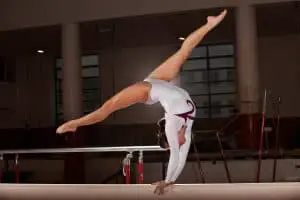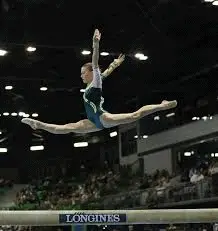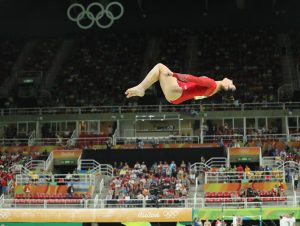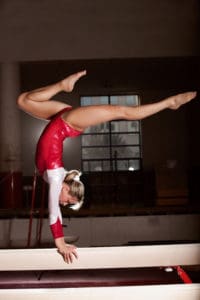Level 8 beam routines continue to build on the skills learned in Levels 6 and 7. Level 8 is the third optional level in gymnastics. Optional gymnastics means that the gymnast gets to use their own choreography, and select skills that meet the requirements for the level. Today we will look at the Level 8 beam routine requirements, and what type of skills can be used to meet them.
Level 8 is the first level in which composition deductions can be taken. These deductions are based on the construction of the routine. Deductions reflect the difficulty, quantity, and type of skills and choreography in the routine. Coaches and gymnasts must design routines based on not only the Special Requirements, but the composition requirements as well.
This post has been updated to reflect the 2022-2026 Code of Points.
Basic Requirements for a Level 8 Beam Routine
Once a gymnast gets to Optional levels (Levels 6-10), they must perform a certain number of skills (Value Parts). Each level has different requirements for the number of skills at varying degrees of difficulty. Missing Value Parts are reflected in the Start Value.
Next, the gymnast must fulfill four Special Requirements on each event. Missing Special Requirements are also reflected in the Start Value.
Finally, the gymnast will have Composition Requirements for each event. Composition deductions are taken at the end of the routine, and are NOT reflected in the Start Value. These deductions are not covered in this article. Read Making Sense of Composition: Level 8 Beam to learn more.

Value Parts for a Level 8 Beam Routine
Level 8 gymnasts need 4 A skills and 4 B skills on each event (bars, beam, and floor). All skills in gymnastics are evaluated based on their difficulty level, and they are given a value from A through E. A skills are the easiest, while B skills are a bit more difficult. The gymnast is allowed to choose the skills that she can perform the best in each of these difficulty categories. Each A skill is worth 0.10, and each B skill is worth 0.30. Deductions are taken off the Start Value if a skill is missing.
In a Level 8 beam routine, gymnasts are allowed to perform A and B skills, along with unlimited C dance elements. They are also allowed ONE acro C without penalty. Performance of additional acro C’s or any D/E skills will result in a 0.50 deduction from the Start Value for a restricted element.
Examples of B skills on beam include:
- Split leap
- Split jump
- Straddle jump
- Pike jump
- Tuck jump 1/2 turn
- Straight jump 3/4 turn
- 1 1/2 turn
- Back handspring (step-out or 2 feet)
- Roundoff
- Dive cartwheel
- Front walkover
- Handstand forward roll
After constructing your Level 8 beam routine, make sure to count the skills. It’s common for a routine to be missing an “A” or “B” Value Part.
If the routine is missing an “A”, consider using an “A” mount (such as a switch-kick to straddle the beam, or a pullover mount). Another easy “A” is a straight jump or beat jump.
If the routine is missing a “B”, try one of the skills from the list above, or any other creative “B” skill that fits the gymnast’s strengths!
Special Requirements for a Level 8 Beam Routine
There are four Special Requirements for a Level 8 beam routine. Each Special Requirement is worth 0.50. If a Special Requirement is missing, it is a deduction of 0.50 off the Start Value.
The Level 8 requirements for beam are as follows:
- Acro series of 2 elements, 1 with flight
- One leap or jump with 180° split
- Minimum 1/1 turn on one foot
- Minimum A salto/aerial dismount
Here is more detail on each of these Special Requirements.

Acro Series of 2 Elements, 1 with Flight
An acro series on beam is a direct connection of at least two acro elements. These elements could be backward, forward, sideward, or a combination of two different directions.
The acro series in a Level 8 beam routine must contain at least one flight element. Examples of flight elements are:
- Back handspring
- Roundoff
- Dive cartwheel
- Dive roll
A direct connection means that the two acro skills are connected with no other skills in between. Dance skills performed between acro skills will break the acro series connection.
The connection between the two acro skills must be smooth and continuous. If this does not occur, the series is considered broken, and the gymnast will not get credit for the Special Requirement.
Reasons any acro series could be considered broken:
- Stop between skills (body completely stops moving)
- Balance error
- Deviation of body movement out of line with the beam (example: gymnast tries to disguise a balance error by continuously moving her trunk to the side before initiating the next skill)
- Repositioning of foot or feet
- Pivoting feet between skills
- Extra step, hop, or jump between skills
- First skill lands in plie, legs completely straighten, then plie again
- Kick/leg swing above 45° before the next skill
Reasons a BACKWARD or SIDEWARD-BACKWARD acro series could be considered broken:
- Slow moving connection
- Arms moving to the thighs or further back after landing of first skill
Example:
Back walkover, back handspring series is performed, but gymnast does not immediately take off into the back handspring, resulting in a slow connection. Series is considered BROKEN.
Note that meeting this Acro Series requirement does NOT mean that the gymnast meets the Acro Composition requirements.
See examples of routines that meet the composition requirements in Making Sense of Composition: Level 8 Beam.
Leap or jump with 180° split

This requirement is pretty self explanatory. The gymnast must perform at least one leap or jump in her routine with 180° split.
The leap or jump can be performed with EITHER a forward or side split (i.e. split jump or straddle jump). The split can be performed in a cross position (facing the end of the beam) or a side position (facing the side of the beam).
Some examples of 180° leaps/jumps are:
- Split leap
- Stag leap (must extend front leg to get credit)
- Split jump (cross or side position)
- Split jump 1/4 turn
- Split jump 1/2 turn
- Switch leap
- Straddle jump (cross or side position)
- Straddle jump 1/4 turn
- Sweetin
- Sissonne
Note: A stag leap or jump must show full extension of the front leg to receive credit for this requirement.
If the leap or jump does not meet the 180° requirement, it can still receive Special Requirement credit if the split is at least 135°. There is a deduction of up to 0.20 for insufficient split, which is applied to all leaps/jumps with a split angle between 135° and 179°.
Leaps/jumps with a split angle below 135° will NOT meet the Special Requirement, and will receive lower Value Part credit.
If the gymnast performs a “C” dance element, it receives “B” credit. Unlimited dance “C” elements are allowed in a Level 8 beam routine. This is a great place to learn dance skills that can receive bonus in Level 9, but be sure that these skills can be performed very cleanly so they don’t receive a lot of deductions!
Minimum 1/1 turn on one foot

The gymnast must perform at least a full turn on one foot to meet this Special Requirement.
Most gymnasts perform a simple full turn, with the leg position optional, but there are other possibilities that will meet the requirement.
Some examples of turns that meet the requirement are:
- Full turn with leg in passe
- Full turn with leg in coupe
- Full turn with free leg straight
- Full turn with leg in front attitude
- Full turn with leg in back attitude
- Full turn in arabesque
- 1 1/2 turn
- Full turn with leg at horizontal
“C” valued turns are allowed, and will receive “B” credit at Level 8.
If a turn is incomplete, it will still receive Value Part credit as long as it is less than 90° incomplete. A deduction of up to 0.20 for incomplete turn may be applied.
A turn that is 90° or more incomplete will receive the lower value. If a full turn is 90° or more incomplete, it will receive credit for a 1/2 turn, which has no Value Part, and it will NOT receive Special Requirement credit.
Minimum “A” salto or aerial dismount

Level 8 gymnasts must finish their routine with a dismount. This dismount must be a salto or aerial in order to get credit for this requirement.
Examples of A-valued salto/aerial dismounts:
- Front tuck
- Front pike
- Front aerial (front layout off 1 foot)
- Barani
- Back tuck
- Back pike
- Back layout
- Gainer back tuck off side of beam
- Gainer back layout off side of beam
Examples of B-valued salto/aerial dismounts:
- Front layout (off 2 feet)
- Front layout 1/2 twist (off 2 feet)
- Front aerial-full (off 1 foot)
- Arabian
- Back tuck, pike, or layout 1/2 twist
- Back tuck, pike, or layout 1/1 twist
- Gainer layout 1/2 to side of beam
- Gainer back tuck off end of beam
In order to get full composition credit for the dismount, the gymnast must perform either:
- A “B” dismount OR
- A “B” acro skill (such as a roundoff or back handspring) into their “A” dismount
Scenarios in which the dismount might not receive credit
1. Gymnast performs a dismount of no value.
Any dismount that is not listed in the Code of Points will not receive Value Part credit, so it cannot receive Special Requirement credit either. If this occurs, the gymnast will lose 0.50 from the Start Value for the Special Requirement, and 0.30 for No Dismount.
2. Dismount performed is a restricted skill.
EXAMPLE: Gymnast performs a back tuck in her routine (C value). Then she performs a piked gainer off the end of the beam (also C value). Level 8 gymnasts may only perform 1 C acro skill in their routine, so the dismount gets 0 VP credit, and therefore no Special Requirement credit either.
3. Dismount does not land on the bottom of the feet first. It would get 0 VP credit, and therefore no Special Requirement credit.
4. Gymnast ends her routine early and does not perform a dismount. In this case, a 0.30 deduction for No Dismount would also apply.
Common Deductions for a Level 8 Beam Routine
In Level 8 gymnastics, gymnasts are expected to perform more difficult skills, but that doesn’t mean they can sacrifice technique. Many times, I have seen a less difficult routine, cleanly executed, beat out a difficult routine with more errors. What do I mean by “cleanly executed”? A gymnast with clean execution has minimal form deductions.
Here are some of the most common deductions that can occur during a Level 8 beam routine. These deductions are assessed each time they occur.
Common deductions include:
- Foot form – 0.05
- Concentration pause – 0.10 (2 seconds)
- Concentration pause – 0.20 (More than 2 seconds)
- Legs not parallel to floor in split or straddle-pike leaps/jumps – up to 0.20
- Insufficient split when required – up to 0.20
- Insufficient amplitude (dance skills, aerials, saltos, or acro flight skills) – up to 0.20
- Incomplete turn/twist – up to 0.20
- Poor body position – up to 0.20
- Incorrect posture on landings of elements and dismount — up to 0.20
- Leg separation – up to 0.20
- Lack of tempo (slow connection) between skills – up to 0.20
- Balance errors – up to 0.30
- Grasp of beam to avoid a fall – 0.30
- Bent arms – up to 0.30
- Bent knees – up to 0.30
- Fall – 0.50
General Deductions in a Level 8 Beam Routine

In a Level 8 beam routine, there are several categories of “general deductions”, which are evaluated by looking at the routine as a whole. These deductions are:
- Rhythm – up to 0.20
- Dynamics – up to 0.20
- Footwork – up to 0.30
- Posture/alignment – up to 0.30
- Sureness – up to 0.20
- Artistry – up to 0.30 (3 categories of artistry)
For more information on general deductions, see 6 General Deductions You’re Probably Getting.
Final Thoughts
The best Level 8 beam routines are clean, dynamic, and confident! As discussed above, it’s best to choose skills that showcase the gymnast’s abilities. For instance, if the gymnast has poor flexibility, she might opt to perform only the minimum elements that require a full split, and use other skills to fulfill the rest of the requirements. Choose a series that can be connected consistently, with good form. The choreography should fit the gymnast’s personality, and show the judges that she is confident and even having fun up on the beam!
The top Level 8 beam routines will also show great rhythm, posture, and footwork. These general categories can really set a routine apart from the rest, so be sure to pay attention to those little details!
Further Reading
The Ideal Composition for a Level 8 Bar Routine
Making Sense of Composition: Level 8 Beam
Making Sense of Composition: Level 8 Floor
Level 8 Floor Routine Requirements
Level 6 Beam Routine Recommendations
Level 7 Beam Routine Recommendations
Making Sense of Composition: Level 9 Beam
Making Sense of Composition: Level 10 Beam
References
USA Gymnastics J.O. Code of Points, 2022-2026.